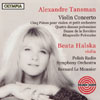Tansman Violin Concerto etc
Tansman’s music is so eclectic it’s hard to identify his true voice, but it is nothing if not tuneful, and is well played and recorded here
View record and artist detailsRecord and Artist Details
Composer or Director: Alexandre Tansman
Label: Olympia
Magazine Review Date: 12/2000
Media Format: CD or Download
Media Runtime: 66
Mastering:
DDD
Catalogue Number: OCD685

Tracks:
| Composition | Artist Credit |
|---|---|
| Concerto for Violin and Orchestra |
Alexandre Tansman, Composer
Alexandre Tansman, Composer Beata Halska, Violin Bernard Le Monnier, Conductor Polish Radio Symphony Orchestra |
| Cinq pièces pour violon et petit orchestre |
Alexandre Tansman, Composer
Alexandre Tansman, Composer Beata Halska, Violin Bernard Le Monnier, Conductor Polish Radio Symphony Orchestra |
| Quatre danses polonaises |
Alexandre Tansman, Composer
Alexandre Tansman, Composer Bernard Le Monnier, Conductor Polish Radio Symphony Orchestra |
| (Le) Jardin du Paradis |
Alexandre Tansman, Composer
Alexandre Tansman, Composer |
| Rhapsodie Polonaise |
Alexandre Tansman, Composer
Alexandre Tansman, Composer Bernard Le Monnier, Conductor Polish Radio Symphony Orchestra |
Author: David Gutman
Listening to this selection of scores from one of 20th-century music’s also-rans, I was reminded of Diaghilev’s advice to the young Prokofiev – that he should learn to hate: ‘the cannon shoots far because it does not scatter its fire’. Alexander Tansman (1897-1986), a Polish-Jewish emigre who spent most of his composing life in Paris and the war years in Los Angeles, is like an over-ingratiating house guest who desperately wants to be liked. While his magpie idiom has been likened to a combination of Ravel and Stravinsky, the music here alludes to just about every influence current in the 1920s. The results are always eminently civilised and beautifully orchestrated, even if they seldom gel into a convincing whole.
Hence the Violin Concerto begins in mysterious Szymanowski-like shadows only to opt for anonymous passagework once the soloist enters. The sugary second subject demonstrates why Tansman might have found employment in Hollywood; it also explains why his efforts there won less renown than Korngold’s. As the movement continues, some of the faster passages recall Roussel, but there is a positively Brahmsian patch before the final flourish. (The composer also has a curious habit of shoe- horning in short-lived fugal episodes of indeterminate tonality.) The second movement opens a la orientale before amiable bustle takes over. The high-lying lyricism of the Adagio cantabile is attractive, though it cries out for the velvet sheen of a Shaham or a Perlman – the soloist here is taxed – while the high jinks of the finale might be more convincing without the stilted cadenza.
Of the remaining works on the programme, the Polish dances are lightweight, surprisingly bland, the Rhapsodie polonaise a little more ambitious. The Cinq pieces, on the other hand, strike a few sparks: several moments pre-empt rather than rip off the neo-classicism of Stravinsky’s Violin Concerto; others are Korngold-lush. The Honegger-like Danse de la sorciere was composed as early as 1923. The booklet-notes imply that this display piece, derived from an abandoned Hans Christian Andersen ballet, is securely in the tradition ofThe Sorcerer’s Apprentice. Perhaps so, and yet it also contains some aggressive harmonic spicing that goes beyond what I take to be its model, Prokofiev’s Chout (or ‘The Buffoon’); this is by some way the most astringent item on the disc.
Undemanding fare in the main then, undeniably tuneful, decently played and agreeably recorded. It could have wide appeal.'
Hence the Violin Concerto begins in mysterious Szymanowski-like shadows only to opt for anonymous passagework once the soloist enters. The sugary second subject demonstrates why Tansman might have found employment in Hollywood; it also explains why his efforts there won less renown than Korngold’s. As the movement continues, some of the faster passages recall Roussel, but there is a positively Brahmsian patch before the final flourish. (The composer also has a curious habit of shoe- horning in short-lived fugal episodes of indeterminate tonality.) The second movement opens a la orientale before amiable bustle takes over. The high-lying lyricism of the Adagio cantabile is attractive, though it cries out for the velvet sheen of a Shaham or a Perlman – the soloist here is taxed – while the high jinks of the finale might be more convincing without the stilted cadenza.
Of the remaining works on the programme, the Polish dances are lightweight, surprisingly bland, the Rhapsodie polonaise a little more ambitious. The Cinq pieces, on the other hand, strike a few sparks: several moments pre-empt rather than rip off the neo-classicism of Stravinsky’s Violin Concerto; others are Korngold-lush. The Honegger-like Danse de la sorciere was composed as early as 1923. The booklet-notes imply that this display piece, derived from an abandoned Hans Christian Andersen ballet, is securely in the tradition of
Undemanding fare in the main then, undeniably tuneful, decently played and agreeably recorded. It could have wide appeal.'
Discover the world's largest classical music catalogue with Presto Music.

Gramophone Digital Club
- Digital Edition
- Digital Archive
- Reviews Database
- Full website access
From £8.75 / month
Subscribe
Gramophone Full Club
- Print Edition
- Digital Edition
- Digital Archive
- Reviews Database
- Full website access
From £11.00 / month
Subscribe
If you are a library, university or other organisation that would be interested in an institutional subscription to Gramophone please click here for further information.




